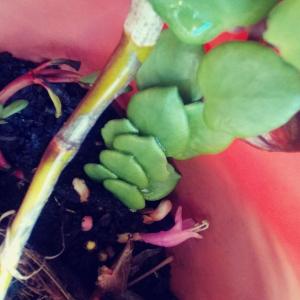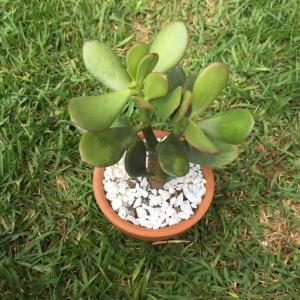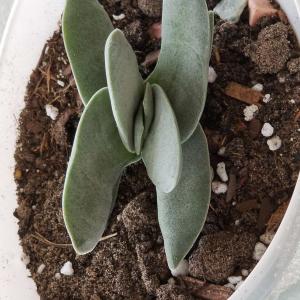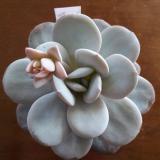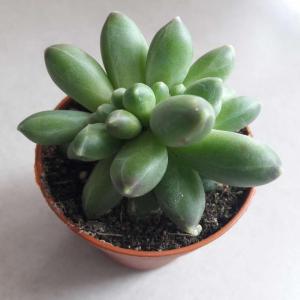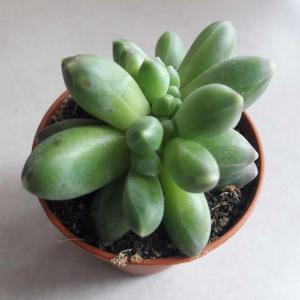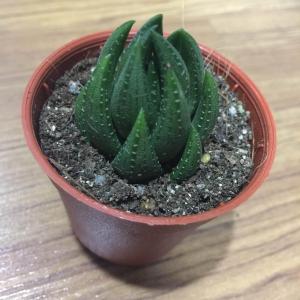求助
meriunkat
2018年04月11日

It rained and i think my plant has talen some damage, i repotted and checked the plant so i know its not rotting but still im wondering whats going on
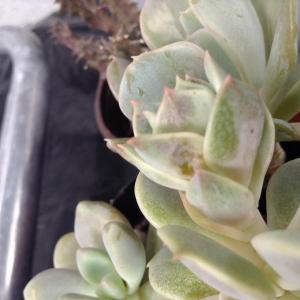
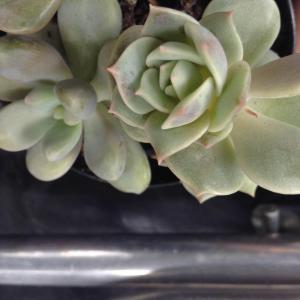
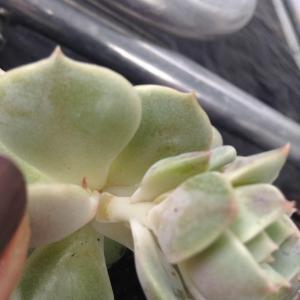



0
0
meriunkat:I found out the plant had come to the end of it's growth so I separated the babies so they can start growing on there own
文章
Miss Chen
2018年04月10日

Determining the water needs of a cucumber plant requires more than reading the seed packet. The quality of the soil, local climate and irrigation method used all affect the amount of water necessary to grow productive cucumbers. Irrigation needs change throughout the gardening season. You must remain attentive throughout the gardening season and determine the cucumber's water needs on a weekly basis.

Soil and Moisture
The type and quality of the soil in the garden influences the water needs of the cucumber plants. The optimum garden provides rich, well-drained soil, but cucumbers can grow successfully in less-optimum soils with proper irrigation. Sandy soils drain quickly so they dry out more often. Cucumbers grown in sandy soil usually require additional irrigation. Clay soil retains water and tends to compact, which inhibits water movement around the cucumber roots. Adding compost or peat moss to the bed before planting aids drainage in heavy soils.
Watering Schedule
Cucumbers typically need 1 to 2 inches of water each week. The plants may require no irrigation when rainfall supplies the required amount of moisture. Feeling the soil before irrigating is a more reliable method of supplying sufficient moisture than sticking to a rigid watering schedule. Cucumbers require watering when the top inch of soil is dry, but before the soil dries at a greater depth. Feel the soil two to three times a week when there is no rainfall and water when necessary. An inch of water thoroughly moistens the top 6 inches of the soil.
Mulch and Water Needs
Mulch affects the amount of watering necessary to maintain your cucumber plants. Plastic mulch applied over the bed before you plant retains the most moisture in the soil, so less watering is necessary. Plastic makes it more difficult to check the soil and deliver water. Installing drip irrigation under the mulch ensures the moisture reaches the soil beneath the mulch. An organic mulch, such as straw, also retains moisture so less watering is necessary. It's possible to water plants with a hose or watering can when organic mulch is applied, and you can still feel the soil beneath the mulch to determine the moisture level.

Watering Tips
Watering the cucumbers in the morning ensures the moisture penetrates to the root zone of the plants before the water evaporates during the heat of the day. Plants watered in the morning may require less irrigation than those watered in the afternoon. Supply the water directly to the soil at the base of instead of from overhead. Overhead watering makes the foliage wet and more prone to fungal growth. More moisture is also lost to evaporation when you overhead water, necessitating more frequent irrigation.

Soil and Moisture
The type and quality of the soil in the garden influences the water needs of the cucumber plants. The optimum garden provides rich, well-drained soil, but cucumbers can grow successfully in less-optimum soils with proper irrigation. Sandy soils drain quickly so they dry out more often. Cucumbers grown in sandy soil usually require additional irrigation. Clay soil retains water and tends to compact, which inhibits water movement around the cucumber roots. Adding compost or peat moss to the bed before planting aids drainage in heavy soils.
Watering Schedule
Cucumbers typically need 1 to 2 inches of water each week. The plants may require no irrigation when rainfall supplies the required amount of moisture. Feeling the soil before irrigating is a more reliable method of supplying sufficient moisture than sticking to a rigid watering schedule. Cucumbers require watering when the top inch of soil is dry, but before the soil dries at a greater depth. Feel the soil two to three times a week when there is no rainfall and water when necessary. An inch of water thoroughly moistens the top 6 inches of the soil.
Mulch and Water Needs
Mulch affects the amount of watering necessary to maintain your cucumber plants. Plastic mulch applied over the bed before you plant retains the most moisture in the soil, so less watering is necessary. Plastic makes it more difficult to check the soil and deliver water. Installing drip irrigation under the mulch ensures the moisture reaches the soil beneath the mulch. An organic mulch, such as straw, also retains moisture so less watering is necessary. It's possible to water plants with a hose or watering can when organic mulch is applied, and you can still feel the soil beneath the mulch to determine the moisture level.

Watering Tips
Watering the cucumbers in the morning ensures the moisture penetrates to the root zone of the plants before the water evaporates during the heat of the day. Plants watered in the morning may require less irrigation than those watered in the afternoon. Supply the water directly to the soil at the base of instead of from overhead. Overhead watering makes the foliage wet and more prone to fungal growth. More moisture is also lost to evaporation when you overhead water, necessitating more frequent irrigation.
0
0
文章
Miss Chen
2018年04月10日

Okra plants turning yellow signal potentially disastrous problems. Yellowed leaves lack chlorophyll, the catalyst that converts sunlight to food for the plant. As the plant starves, okra's natural resistance to insects and disease declines. Yellowed leaves sometimes indicate problems gardeners can easily remedy, but other issues require long-term solutions, such as crop rotation and soil improvement.

Poor Soil
Planting okra seed in soil colder than 65 degrees Fahrenheit could cause immediate root problems. Waiting to plant until about 10 days after the last frost date gives soil time to warm enough for okra. Mounding the planting row also raises the soil temperature. Lack of nitrogen could also cause yellowing problems in okra, which needs rich well-drained soil for proper growth. Increasing the amount of organic material in the ground improves drainage and reduces okra problems in heavy clay. Cultivate the ground deeply before planting, turning over the top 8 to 10 inches of soil.
Fungal Infection
Dense clay soils with poor drainage provide favorable conditions for fungal disease in okra. Okra shows no resistance to verticillium wilt, which damages okra roots and causes wilting and yellowing of the plant above ground. Lower leaves show symptoms first, and problems move higher on the plant as the disease spreads. Leaves shrivel and die in the final stages of the infection. No chemical treatment will help okra infected with verticillium wilt. Fungal spores overwinter in soil, setting the stage for more problems. Solarization by heating the upper layers of soil under clear plastic sheeting reduces the incidence of verticillium wilt.
Insect Problems
Sucking insects could attack okra, and cause loss of vigor and dying leaves. Red spider mites suck the plant's sap from leaf surfaces, causing a speckled, white or yellow pattern on leaves. In heavy infestations, leaves turn pale and then shrivel and brown. Aphids also drain the plant of nourishment by sucking fluid from leaves and stems. Both adult tobacco whiteflies and whitefly nymphs feed on okra sap and could cause plants to wilt and yellow. Checking the undersides of leaves and the stems of okra plants should reveal any insect problems. Spraying the plants with insecticidal soap destroys soft-bodied pests.

Nematodes
Nematodes could cause serious damage to okra as the small roundworms bore into roots. When the plant's wound heals, galls or root-knots form. Severely affected okra plants lose the ability to draw up water and nutrition from the soil. The upper plant yellows and dies. No chemical treatments are approved for nematode problems in the home garden, according to the University of Florida Extension. Gardeners can control nematodes through crop rotation, planting okra after crops such as corn, brassicas or onions. Cover cropping with marigolds and turning the plants under reduces nematode numbers. Improving soil quality by adding humus and repeatedly tilling the ground also prepares a healthier plot for okra.

Poor Soil
Planting okra seed in soil colder than 65 degrees Fahrenheit could cause immediate root problems. Waiting to plant until about 10 days after the last frost date gives soil time to warm enough for okra. Mounding the planting row also raises the soil temperature. Lack of nitrogen could also cause yellowing problems in okra, which needs rich well-drained soil for proper growth. Increasing the amount of organic material in the ground improves drainage and reduces okra problems in heavy clay. Cultivate the ground deeply before planting, turning over the top 8 to 10 inches of soil.
Fungal Infection
Dense clay soils with poor drainage provide favorable conditions for fungal disease in okra. Okra shows no resistance to verticillium wilt, which damages okra roots and causes wilting and yellowing of the plant above ground. Lower leaves show symptoms first, and problems move higher on the plant as the disease spreads. Leaves shrivel and die in the final stages of the infection. No chemical treatment will help okra infected with verticillium wilt. Fungal spores overwinter in soil, setting the stage for more problems. Solarization by heating the upper layers of soil under clear plastic sheeting reduces the incidence of verticillium wilt.
Insect Problems
Sucking insects could attack okra, and cause loss of vigor and dying leaves. Red spider mites suck the plant's sap from leaf surfaces, causing a speckled, white or yellow pattern on leaves. In heavy infestations, leaves turn pale and then shrivel and brown. Aphids also drain the plant of nourishment by sucking fluid from leaves and stems. Both adult tobacco whiteflies and whitefly nymphs feed on okra sap and could cause plants to wilt and yellow. Checking the undersides of leaves and the stems of okra plants should reveal any insect problems. Spraying the plants with insecticidal soap destroys soft-bodied pests.

Nematodes
Nematodes could cause serious damage to okra as the small roundworms bore into roots. When the plant's wound heals, galls or root-knots form. Severely affected okra plants lose the ability to draw up water and nutrition from the soil. The upper plant yellows and dies. No chemical treatments are approved for nematode problems in the home garden, according to the University of Florida Extension. Gardeners can control nematodes through crop rotation, planting okra after crops such as corn, brassicas or onions. Cover cropping with marigolds and turning the plants under reduces nematode numbers. Improving soil quality by adding humus and repeatedly tilling the ground also prepares a healthier plot for okra.
0
0
成长记
Susi 🌿
2018年04月09日

Probably the oldest plant in my garden. There are 3 colors in one plant joined by grafting




1
0
文章
Miss Chen
2018年04月09日

Eggplant (Solanum melongena) is winter hardy and perennial in U.S. Department of Agriculture plant hardiness zones 9 to 12, but in most parts of the country it is grown as an annual garden vegetable. It is not tolerant of cold temperatures, and for good fruit development, it requires a long frost-free growing season. The plant is thought to have originated in India more than 1,500 years ago and to have come to North America with Spanish explorers sometime before the 19th century.
Seedlings
Eggplant seeds take one to two weeks to germinate after they're planted, and seedlings will be big and sturdy enough to transplant outdoors within six to 10 weeks after germination. Young plants are vulnerable to damage from frost and cold temperatures, so seedlings shouldn't be transplanted until the soil is warm, nighttime temperatures are consistently above 65 degrees Fahrenheit, and all danger of frost has passed.

Mature Plants
Mature plants are relatively large with branching stems, and their large leaves are oval-shaped or lobed, with a hairy, sometimes spiny, texture. Most eggplant varieties grow to a height of between 2 and 4 feet and may need support from a stake or cage when they're laden with heavy fruit. Some varieties, however, are compact and remain less than 2 feet tall.
In mid-summer, plants bloom with star-shaped purple flowers which occur either singly or in clusters of two blossoms.
The optimal daytime temperature for the plant's growth is between 70 and 85 degrees F, and if temperatures are above 95 degrees F, flowers and fruit may not develop properly.
Fruit Development
The flowers develop into fruit that, depending on the cultivar, vary in size, color and shape. The varieties traditionally grown in the United States produce fruit that is oval or pear-shaped and up to approximately 9 inches long, with a thick purple-black skin and dense white inner flesh. Varieties known as Asian, Chinese or Japanese eggplant produce fruit that is more elongated and slender. The fruit of other cultivars may be white, green, light purple or striped.

Eggplant fruit is ready for harvest when its skin is smooth and shiny and its flesh is firm. Fruit with dull or wrinkled skin or soft flesh is over-ripe; at this stage, the fruit's skin will be tough and its flavor likely bitter. Mature fruit is typically ready to harvest about 70 days after the plants have been set in the garden.
Seedlings
Eggplant seeds take one to two weeks to germinate after they're planted, and seedlings will be big and sturdy enough to transplant outdoors within six to 10 weeks after germination. Young plants are vulnerable to damage from frost and cold temperatures, so seedlings shouldn't be transplanted until the soil is warm, nighttime temperatures are consistently above 65 degrees Fahrenheit, and all danger of frost has passed.

Mature Plants
Mature plants are relatively large with branching stems, and their large leaves are oval-shaped or lobed, with a hairy, sometimes spiny, texture. Most eggplant varieties grow to a height of between 2 and 4 feet and may need support from a stake or cage when they're laden with heavy fruit. Some varieties, however, are compact and remain less than 2 feet tall.
In mid-summer, plants bloom with star-shaped purple flowers which occur either singly or in clusters of two blossoms.
The optimal daytime temperature for the plant's growth is between 70 and 85 degrees F, and if temperatures are above 95 degrees F, flowers and fruit may not develop properly.
Fruit Development
The flowers develop into fruit that, depending on the cultivar, vary in size, color and shape. The varieties traditionally grown in the United States produce fruit that is oval or pear-shaped and up to approximately 9 inches long, with a thick purple-black skin and dense white inner flesh. Varieties known as Asian, Chinese or Japanese eggplant produce fruit that is more elongated and slender. The fruit of other cultivars may be white, green, light purple or striped.

Eggplant fruit is ready for harvest when its skin is smooth and shiny and its flesh is firm. Fruit with dull or wrinkled skin or soft flesh is over-ripe; at this stage, the fruit's skin will be tough and its flavor likely bitter. Mature fruit is typically ready to harvest about 70 days after the plants have been set in the garden.
0
0
文章
Miss Chen
2018年04月09日

给友友们普及一下多肉的专业术语:
1、多肉植物(succulent plant ) 又称肉质植物、多浆植物,为茎、叶肉质,具有肥厚贮水组织的观赏植物。茎肉质多浆的如仙人掌科植物,叶肉质多浆的如龙舌兰科、景天科、大戟科等多肉植物。多肉植物的爱好者也喜欢简称其为“肉肉”。
2、科名(family)植物分类单位的学术用语,凡是花的形态结构接近的一个属或几个属,可以组成植物分类系统的一个科。如景天科由30个属组成。
3、属名(genus)植物分类单位的学术用语,每一个植物学名,必须由属名、种名和定名人组成。每一个属下可以包括一种至若干种。
4、种名(species)植物分类单位的学术用语,又叫学名,每一种植物只有一个学名。在属名之后,变种或栽培品种名之前。例如芦荟(Aloe vera var.chinensis),其中Aloe为属名为种名var.chinensis为变种名。
5、变种(variety)物种与亚种之下的分类单位。如仙人掌科中的类栉球就是栉刺尤伯球的变种,狂刺金唬是金唬的变种等。
6、茎干状多肉植物(caudex succulent) 植物的肉质部分主要在茎的基部,形成膨大而形状不一的肉质块状体或球状体。如京舞妓、椭叶木棉、光堂等。
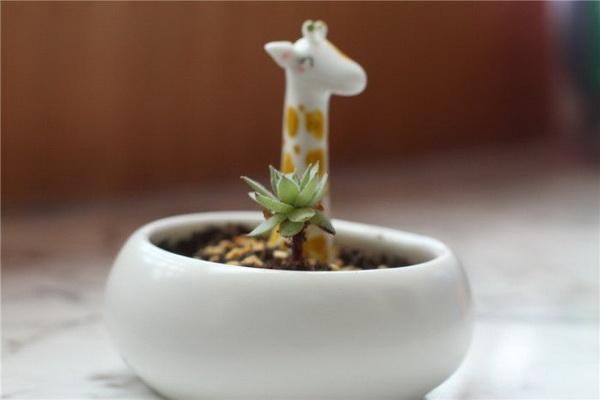
7、雌雄异株(heterothallism) 指单性花分别着生于不同植株上,由此,出现了雄株和雌株之分。
8、两性花(hermaphrodite flower)一朵花中,兼有雄蕊群和雌蕊群。大多数多肉植物为两性花,开花后都能正常结实。
9、单生(simple,solitary) 指植株茎干单独生长不产生分枝和不生子球。如仙人掌中的翁柱和金唬。
10、群生(clustering) 指许多密集的新枝或子球生长在一起。如仙人掌中的松霞,多肉植物中的茜之塔等。
11、休眠(dormancy)植物处于自然生长停顿状态,还会出现落叶或地上部死亡的现象。常发生在冬季和夏季。
12、夏型种(summer type) 生长期在夏季,而冬季呈休眠状态的多肉植物,称之夏型植物或冬眠型植物。主要是开花的时间在夏季。这里的夏季指肉肉在原产地的夏季气候,如果天气太热,肉肉依旧会休眠。
13、冬型种(winter type)生长期在冬季,而夏季呈休眠状态,称之冬型植物或夏眠型植物。这里的冬季是指肉肉在原产地的冬季气候,如果夭气太冷,肉肉依旧会休眠。
14、攀援茎(climbing stem) 依靠特殊结构攀援它物而向上生长的茎。如景天科中的极乐鸟,薯菠科中的龟甲龙等。
15、气生根(aerial roots) 由地上部茎所长出的根,在虹之玉、梅兔耳的成年植株上经常可见。
16、软质叶(soft leaf) 多肉植物中柔嫩多汁、很容易被折断或为病虫所害的有些种类的叶片。一般称其为软质叶系,如十二卷属中的玉露等。
17、硬质叶(thick leaf) 指多肉植物中一些叶片肥厚坚硬的种类。一般称其为硬质叶系,如十二卷属中的琉璃殿、条纹十二卷等。
18、莲座叶丛(rosette)指紧贴地面的短茎上,辐射状丛生多叶的生长形态,其叶片排列的方式形似莲花。如景天科的石莲花属、风车草属等。
19、叶齿(leaf-teeth) 常指多肉植物肥厚叶片边缘的肉质刺状物。常见于百合科芦荟属植物,如不夜城、不夜城锦、翡翠殿等。
20、叶刺(leaf thorn)由叶的一部分或全部转变成的刺状物,叶刺可以减少蒸腾并起到保护作用。如仙人掌科植物的刺就是叶刺。
21、窗(window) 许多多肉植物,如百合科的十二卷属,其叶面顶端有透明或半透明部分,称之为“窗”。其窗面的变化也是品种的分类依据。
22、吸芽(absorptive bud)又叫分孽(nie),是植物地下茎的节上或地上茎的腋芽中产生的芽状体。如长生草、石莲花等母株旁生的小植株。
23、叶痕(leaf scar) 叶脱落后,在茎枝上所留下的叶柄断痕。叶痕的排列顺序与大小,可作为鉴别植物种类的依据。
24、杂交(hybridization) 使两种植物杂交以便获得具两种亲本特性的新品种的行为。例如白牡丹为石莲花属与风车属的属间杂交品种。
25、嫁接(grafting)把母株的茎、子球接到砧木上使其结合成为新植株的一种繁殖方法。用于嫁接的茎、统突或子球叫做接穗,承受接穗的植物称为砧木。
26、砧木(stock)又称台木。植物嫁接繁殖时与接穗相接的植株。在仙人掌植物的嫁接中,普遍使用量天尺做砧木,多肉植物则常采用霸王鞭做砧木。
27、叶插(leaf cutting) 将多肉植物叶片的一部分插于基质中,促使生根,长成新的植株的一种繁殖方法。
28、更新(renewal) 通过修剪手段,包括重剪和剪除老枝等办法,促使新的枝条生长。
29、晾根(air-cured root)当土壤过湿和根部病害,导致多肉植物发生烂根,出现黄叶时,可将植株从土壤中取出,把根部暴露在空气中晾干,利于消灭病菌和恢复生机。
30、锦(variegation)又称彩斑、斑锦。茎部全体或局部丧失了制造叶绿素的功能,而其他色素相对活跃,使茎部表面出现红、黄、白、紫、橙等色或色斑。在品名写法上常用f.vataegata或‘Variegata/“。
31、缀化(fasciation) 或称冠,是一种不规则的芽变现象。这种畸形的缀化,是某些分生组织细胞反常性发育的结果,其学名的写法上常用f.crmata或/“Cristata/“。
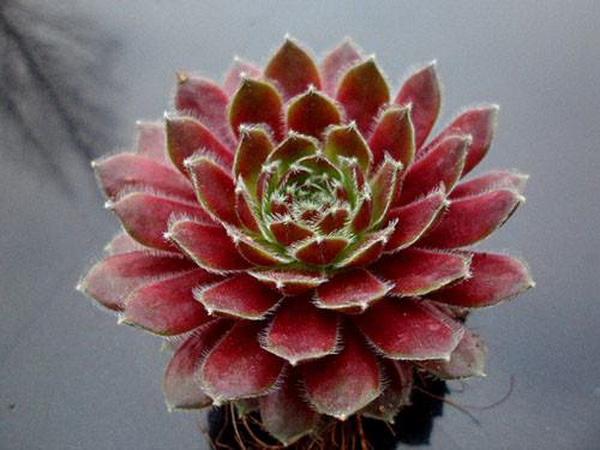
32、冠状(cristate)叶部、茎部或花朵呈鸡冠状生长,又称鸡冠状,如绯牡丹缀化。
33、芽变(bud mutation) 一个植物营养体出现的与原植物不同、可以遗传并可用无性繁殖的方法保存下来的性状。如多肉植物中的许多斑锦和扁化品种。
34、突变(mutation)指植物的遗传组织发生突然改变的现象,使植株出现新的特征,且这种新的特征可遗传于子代中。多肉植物还可以通过嫁接方法把新的特征固定下来。
35、黄化(yellowing)指植物由于缺乏光照,造成叶片褪色变黄和茎部过度生长的现象。
1、多肉植物(succulent plant ) 又称肉质植物、多浆植物,为茎、叶肉质,具有肥厚贮水组织的观赏植物。茎肉质多浆的如仙人掌科植物,叶肉质多浆的如龙舌兰科、景天科、大戟科等多肉植物。多肉植物的爱好者也喜欢简称其为“肉肉”。
2、科名(family)植物分类单位的学术用语,凡是花的形态结构接近的一个属或几个属,可以组成植物分类系统的一个科。如景天科由30个属组成。
3、属名(genus)植物分类单位的学术用语,每一个植物学名,必须由属名、种名和定名人组成。每一个属下可以包括一种至若干种。
4、种名(species)植物分类单位的学术用语,又叫学名,每一种植物只有一个学名。在属名之后,变种或栽培品种名之前。例如芦荟(Aloe vera var.chinensis),其中Aloe为属名为种名var.chinensis为变种名。
5、变种(variety)物种与亚种之下的分类单位。如仙人掌科中的类栉球就是栉刺尤伯球的变种,狂刺金唬是金唬的变种等。
6、茎干状多肉植物(caudex succulent) 植物的肉质部分主要在茎的基部,形成膨大而形状不一的肉质块状体或球状体。如京舞妓、椭叶木棉、光堂等。

7、雌雄异株(heterothallism) 指单性花分别着生于不同植株上,由此,出现了雄株和雌株之分。
8、两性花(hermaphrodite flower)一朵花中,兼有雄蕊群和雌蕊群。大多数多肉植物为两性花,开花后都能正常结实。
9、单生(simple,solitary) 指植株茎干单独生长不产生分枝和不生子球。如仙人掌中的翁柱和金唬。
10、群生(clustering) 指许多密集的新枝或子球生长在一起。如仙人掌中的松霞,多肉植物中的茜之塔等。
11、休眠(dormancy)植物处于自然生长停顿状态,还会出现落叶或地上部死亡的现象。常发生在冬季和夏季。
12、夏型种(summer type) 生长期在夏季,而冬季呈休眠状态的多肉植物,称之夏型植物或冬眠型植物。主要是开花的时间在夏季。这里的夏季指肉肉在原产地的夏季气候,如果天气太热,肉肉依旧会休眠。
13、冬型种(winter type)生长期在冬季,而夏季呈休眠状态,称之冬型植物或夏眠型植物。这里的冬季是指肉肉在原产地的冬季气候,如果夭气太冷,肉肉依旧会休眠。
14、攀援茎(climbing stem) 依靠特殊结构攀援它物而向上生长的茎。如景天科中的极乐鸟,薯菠科中的龟甲龙等。
15、气生根(aerial roots) 由地上部茎所长出的根,在虹之玉、梅兔耳的成年植株上经常可见。
16、软质叶(soft leaf) 多肉植物中柔嫩多汁、很容易被折断或为病虫所害的有些种类的叶片。一般称其为软质叶系,如十二卷属中的玉露等。
17、硬质叶(thick leaf) 指多肉植物中一些叶片肥厚坚硬的种类。一般称其为硬质叶系,如十二卷属中的琉璃殿、条纹十二卷等。
18、莲座叶丛(rosette)指紧贴地面的短茎上,辐射状丛生多叶的生长形态,其叶片排列的方式形似莲花。如景天科的石莲花属、风车草属等。
19、叶齿(leaf-teeth) 常指多肉植物肥厚叶片边缘的肉质刺状物。常见于百合科芦荟属植物,如不夜城、不夜城锦、翡翠殿等。
20、叶刺(leaf thorn)由叶的一部分或全部转变成的刺状物,叶刺可以减少蒸腾并起到保护作用。如仙人掌科植物的刺就是叶刺。
21、窗(window) 许多多肉植物,如百合科的十二卷属,其叶面顶端有透明或半透明部分,称之为“窗”。其窗面的变化也是品种的分类依据。
22、吸芽(absorptive bud)又叫分孽(nie),是植物地下茎的节上或地上茎的腋芽中产生的芽状体。如长生草、石莲花等母株旁生的小植株。
23、叶痕(leaf scar) 叶脱落后,在茎枝上所留下的叶柄断痕。叶痕的排列顺序与大小,可作为鉴别植物种类的依据。
24、杂交(hybridization) 使两种植物杂交以便获得具两种亲本特性的新品种的行为。例如白牡丹为石莲花属与风车属的属间杂交品种。
25、嫁接(grafting)把母株的茎、子球接到砧木上使其结合成为新植株的一种繁殖方法。用于嫁接的茎、统突或子球叫做接穗,承受接穗的植物称为砧木。
26、砧木(stock)又称台木。植物嫁接繁殖时与接穗相接的植株。在仙人掌植物的嫁接中,普遍使用量天尺做砧木,多肉植物则常采用霸王鞭做砧木。
27、叶插(leaf cutting) 将多肉植物叶片的一部分插于基质中,促使生根,长成新的植株的一种繁殖方法。
28、更新(renewal) 通过修剪手段,包括重剪和剪除老枝等办法,促使新的枝条生长。
29、晾根(air-cured root)当土壤过湿和根部病害,导致多肉植物发生烂根,出现黄叶时,可将植株从土壤中取出,把根部暴露在空气中晾干,利于消灭病菌和恢复生机。
30、锦(variegation)又称彩斑、斑锦。茎部全体或局部丧失了制造叶绿素的功能,而其他色素相对活跃,使茎部表面出现红、黄、白、紫、橙等色或色斑。在品名写法上常用f.vataegata或‘Variegata/“。
31、缀化(fasciation) 或称冠,是一种不规则的芽变现象。这种畸形的缀化,是某些分生组织细胞反常性发育的结果,其学名的写法上常用f.crmata或/“Cristata/“。

32、冠状(cristate)叶部、茎部或花朵呈鸡冠状生长,又称鸡冠状,如绯牡丹缀化。
33、芽变(bud mutation) 一个植物营养体出现的与原植物不同、可以遗传并可用无性繁殖的方法保存下来的性状。如多肉植物中的许多斑锦和扁化品种。
34、突变(mutation)指植物的遗传组织发生突然改变的现象,使植株出现新的特征,且这种新的特征可遗传于子代中。多肉植物还可以通过嫁接方法把新的特征固定下来。
35、黄化(yellowing)指植物由于缺乏光照,造成叶片褪色变黄和茎部过度生长的现象。
2
8



